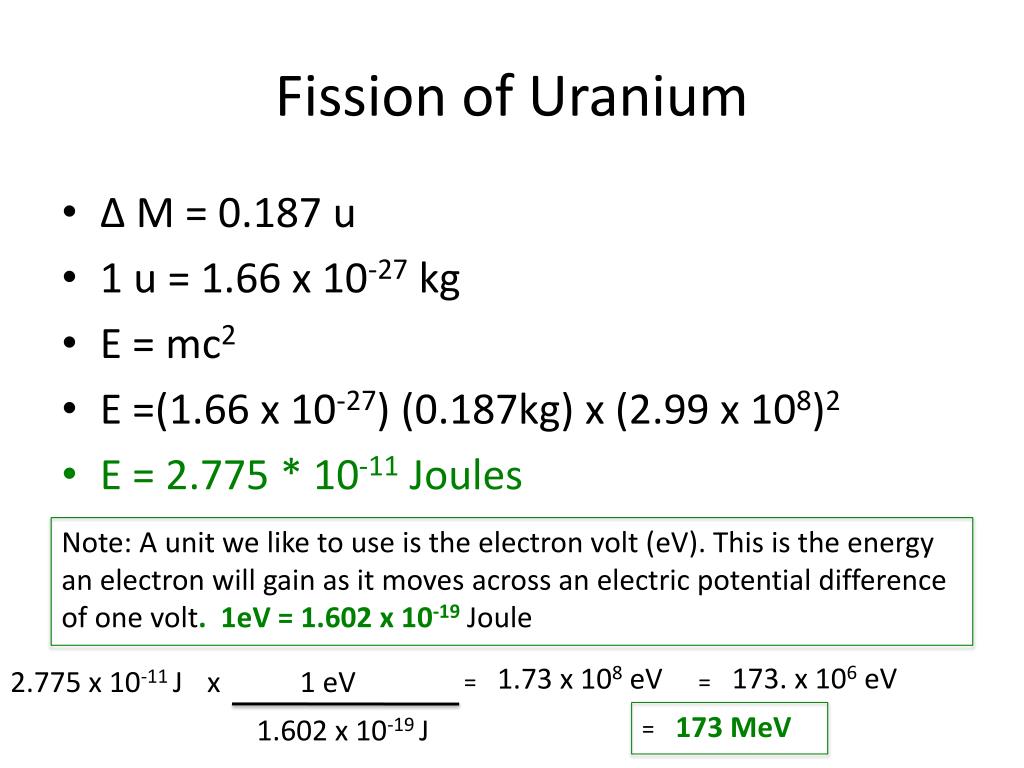
There are two ways this can happen: nuclear fusion and nuclear fission. Nuclear energy is energy that is released when atomic nuclei change.
#Uranium nuclear fission equation plus#
The guide also contains over 25 practice questions plus four exam-style questions to allow you to test your knowledge and understanding.
#Uranium nuclear fission equation full#
The study guide is full of concise, easy-to-understand explanations of complicated concepts that can help you stay on top of your IB Chemistry Option C studies. If you’re studying IB Chemistry Option C: Energy then this straightforward explanation of nuclear fusion and nuclear fission extracted from our IB study guide, Chemistry Option C: Energy Standard and Higher Level written by Tony Hickling, is for you. IB Chemistry is known for being a challenging subject, so we’ve pulled some useful explanations of key concepts from our study guides to help make your revision a bit easier. This normally emits an electron and an anti-neutrino ( In the thorium cycle, fuel is formed when 232Ĭaptures a neutron (whether in a fast reactor or thermal reactor) to become 233 As such they conclude there is little chance of thorium cycles replacing conventional uranium cycles in the current nuclear power market, despite the potential benefits. Ī 2011 MIT study concluded that although there is little in the way of barriers to a thorium fuel cycle, with current or near term light-water reactor designs there is also little incentive for any significant market penetration to occur. In 2006 Sorensen started "" to promote and make information available about this technology. He first researched thorium reactors while working at NASA, while evaluating power plant designs suitable for lunar colonies. Kirk Sorensen, former NASA scientist and Chief Technologist at Flibe Energy, has been a long-time promoter of thorium fuel cycle and particularly liquid fluoride thorium reactors (LFTRs).

Rubbia's proposal offered the potential to incinerate high-activity nuclear waste and produce energy from natural thorium and depleted uranium. In 1993, Carlo Rubbia proposed the concept of an energy amplifier or "accelerator driven system" (ADS), which he saw as a novel and safe way to produce nuclear energy that exploited existing accelerator technologies.

The MSR program was defunded in 1976 after its patron Alvin Weinberg was fired. Molten salt reactor (MSR) experiments assessed thorium's feasibility, using thorium(IV) fluoride dissolved in a molten salt fluid that eliminated the need to fabricate fuel elements. Īt Oak Ridge National Laboratory in the 1960s, the Molten-Salt Reactor Experiment used 233Īs the fissile fuel in an experiment to demonstrate a part of the Molten Salt Breeder Reactor that was designed to operate on the thorium fuel cycle. While thorium is more abundant in the continental crust than uranium and easily extracted from monazite as a side product of rare earth element mining, it is much less abundant in seawater than uranium. In the twenty-first century thorium's claimed potential for improving proliferation resistance and waste characteristics led to renewed interest in the thorium fuel cycle. A notable exception was India's three-stage nuclear power programme. However, for most countries uranium was relatively abundant and research in thorium fuel cycles waned.

It was envisioned that as uranium reserves were depleted, thorium would supplement uranium as a fertile material. History Ĭoncerns about the limits of worldwide uranium resources motivated initial interest in the thorium fuel cycle.

The thorium fuel cycle has several potential advantages over a uranium fuel cycle, including thorium's greater abundance, superior physical and nuclear properties, reduced plutonium and actinide production, and better resistance to nuclear weapons proliferation when used in a traditional light water reactor though not in a molten salt reactor. Depending on the design of the reactor and fuel cycle, the generated 233Įither fissions in situ or is chemically separated from the used nuclear fuel and formed into new nuclear fuel. This parallels the process in uranium breeder reactors whereby fertile 238 Additional fissile material or another neutron source is necessary to initiate the fuel cycle. ), which are insufficient to initiate a nuclear chain reaction. Unlike natural uranium, natural thorium contains only trace amounts of fissile material (such as 231 Is transmuted into the fissile artificial uranium isotope 233 The thorium fuel cycle is a nuclear fuel cycle that uses an isotope of thorium, 232


 0 kommentar(er)
0 kommentar(er)
